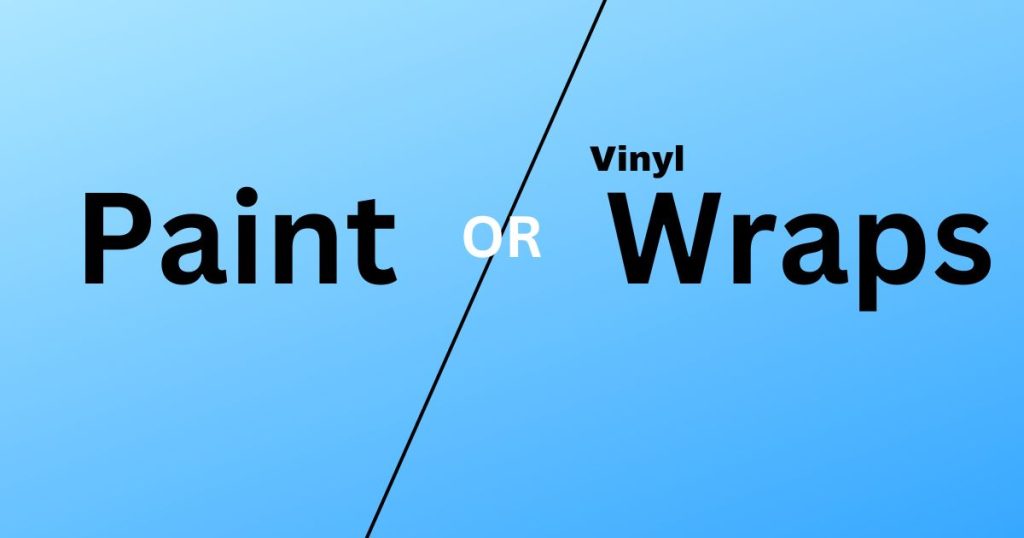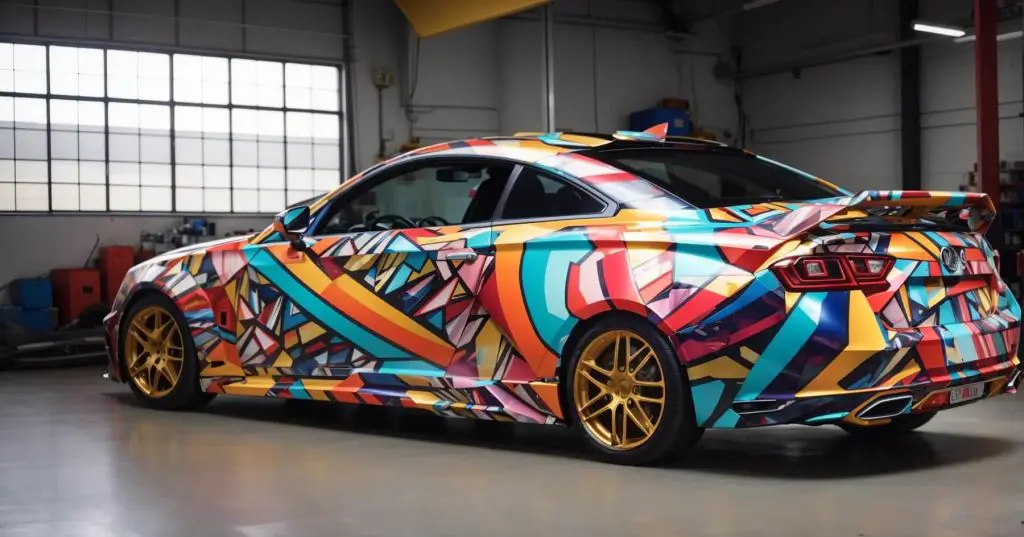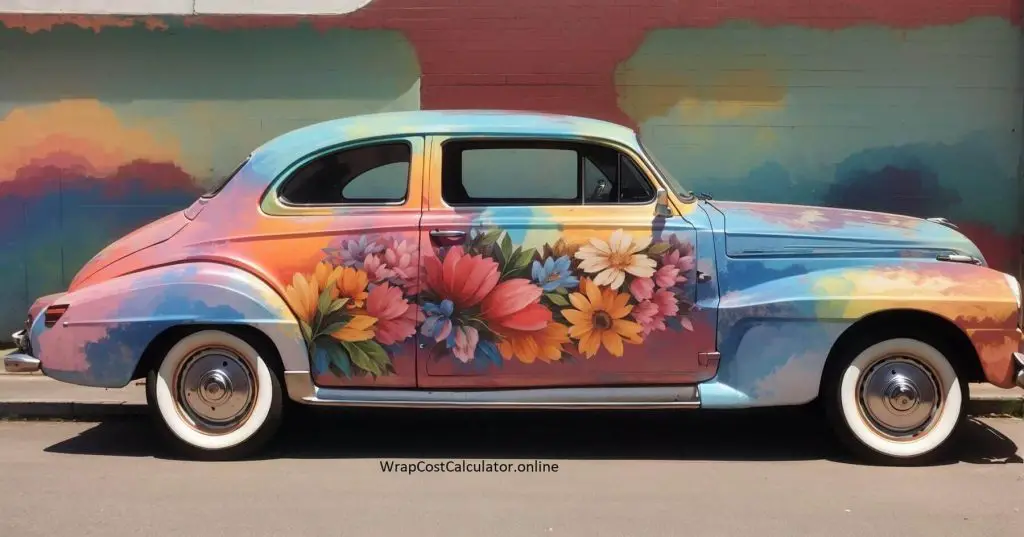There’s a saying that your car is an extension of your personality. Whether you’re looking to showcase your style or simply protect your car’s finish, the choice between car wraps and paint is a crucial one. Car wraps involve applying a vinyl film to the vehicle’s exterior, allowing for a wide range of colors, patterns, and finishes. On the other hand, traditional paint provides a classic and seamless look but may come with certain limitations.

Car Wrap vs Paint: Pros and Cons
Car Wraps Pros:
Car wraps have gained popularity for their ability to transform a vehicle’s appearance dramatically. Here’s what makes car wraps a tempting choice:

- Protection: Vinyl wraps offer a layer of protection for your vehicle’s original paint, shielding it from minor scratches, UV rays, and road debris.
- Customization: Car vinyl provide endless design possibilities, allowing you to create unique and eye-catching visuals that suit your personal style.
- Easy Removal: Car wraps can be removed without damaging the original paint, giving you the flexibility to change the vehicle’s appearance without committing to a permanent change.
- Cost-Effective: In many cases, car wraps can be more cost-effective than a high-quality traditional paint, especially for complex designs.
- Advertising: Car vinyl can serve as a mobile billboard for businesses, helping with branding and promotional efforts.
- Eco-Friendliness of Car Wraps: Car wraps are considered more environmentally friendly than traditional painting, as they generate fewer volatile organic compounds (VOCs) and require less energy to produce and apply.
Wraps Cons:
- Durability: Car wraps have a limited lifespan of about 5 to 7 years, after which they may start to show signs of wear and require replacement.
- Installation Quality: Improper installation can lead to bubbles, creases, or misalignments, affecting the appearance of the wrap.
- Maintenance: Car vinyl wraps require regular cleaning with specific products to maintain their appearance, and neglecting maintenance can lead to premature deterioration.
- Limited Repairs: Once a car wrap is damaged, repairs can be more challenging compared to traditional paint, often requiring a partial or full replacement.
- Complex Designs: Extremely intricate or detailed designs might be harder to execute perfectly on a car wrap, potentially leading to imperfections.
Paint Pros:

- Timeless Elegance: Traditional paint provides a classic, glossy finish that enhances the vehicle’s overall aesthetic appeal.
- Longevity: Well-maintained traditional paint can last for several years and is more resistant to wear and tear over time compared to car wraps.
- Seamless Repairs: Minor damages to traditional paint can be easily repaired with touch-ups, maintaining a consistent appearance.
- Intricate Detailing: Skilled painters can create complex designs, patterns, and detailing that may be more challenging with car wraps.
- Resale Value: A well-maintained original paint can contribute positively to the vehicle’s resale value.
Paint Cons
- Cost: Traditional painting can be more expensive due to labor-intensive processes and the need for specialized equipment.
- Vulnerability: Traditional paint is more susceptible to chips, scratches, fading, and damage from environmental factors.
- Limited Customization: While traditional paint can be customized, achieving intricate and complex designs may be more difficult compared to car wraps.
- Time-Consuming: The traditional painting process involves multiple layers and drying times, making it more time-consuming compared to applying a car wrap.
- Environmental Impact: Traditional painting processes can generate higher VOC emissions and require more energy, potentially impacting the environment.
Why Car Wraps are less expensive then Paint?
In general, a car wrap will cost less than a paint. There are several reasons for this:
- Wraps are generally less labor-intensive to apply than paint. A wrap can be applied directly to the vehicle’s surface, while a paint requires the vehicle to be disassembled and sanded down before the new paint can be applied.
- Wraps use less material than paint. A wrap only covers the surface of the vehicle, while a paint job requires enough paint to cover the entire vehicle.
- Wraps are less expensive to remove than paint. If you decide to remove a wrap, it can be peeled off without damaging the original paint. Removing paint, on the other hand, requires sanding and repainting, which can be a time-consuming and costly process.
Decision Time: Choosing Between Car Wrap and Paint
Car wrap is a good option for people who want to change the appearance of their vehicle without committing to a permanent change and those working with a limited budget. The paint option is a better option for people who want a permanent change and are willing to invest in a more durable and long-lasting solution.
However, it’s important to note that the cost of a wrap or paint job will depend on several factors, including the size of the vehicle, the quality of the materials used, and the complexity of the design. A wrap or paint for a small car will generally cost less than one for a large truck or SUV. Custom wraps or paint , or those using high-quality materials, will also generally be more expensive.
Conclusion
In the debate of car wrap vs paint, there’s no one-size-fits-all answer. Both options offer unique advantages, and the right choice depends on your preferences, budget, and intended use. Car wraps allow for creativity and protection, while paint delivers a timeless elegance. Consider your long-term goals, style, and practicality to make the best decision for transforming your vehicle.
Do Vehicle Wraps Damage Paint?
In general, a vehicle wrap should not damage the paint job on a vehicle. A wrap is applied directly to the surface of the vehicle, and if it is applied and removed properly, it should not damage the underlying paint.
Is it better to wrap or repaint a car?
The answer to this question depends on personal preference and specific circumstances. If you want to change your car’s appearance temporarily or protect the original paint, wrapping is a better option. However, if you desire a permanent color change or a flawless finish, repainting is the way to go.
What lasts longer, a wrap or a paint job?
A well-maintained vinyl wrap can last up to 5-7 years, while a quality paint job can endure for 10 years or more. However, it’s important to note that the lifespan of a wrap depends on factors such as climate, maintenance, and exposure to sunlight.
Is it bad to wrap a car in the winter?
Wrapping a car in the winter can be challenging due to temperature constraints. Low temperatures can affect the adhesion of the vinyl, making it more difficult to achieve a seamless finish. It is recommended to wrap a car in a controlled environment with optimal temperature and humidity levels.
What’s better, Plasti Dip or vinyl wrap?
Both Plasti Dip and vinyl wrap offer temporary color changes, but each has its advantages. Plasti Dip is a rubberized coating that can be easily peeled off, making it ideal for temporary modifications. Vinyl wrap, on the other hand, offers more color options, finishes, and better protection against scratches and stone chips.